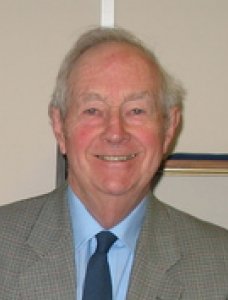IASPEI Medal Winners
IASPEI Medal
International Cooperation for Better Understanding of the Earth
The award of a IASPEI medal has been decided during the General Assembly in Melbourne and will therefore be given for the first time at the IASPEI Opening Plenary in Gothenburg. The IASPEI medal is awarded for merits in seismology: for sustaining IASPEI goals and activities and for scientific merits in the field of seismology and physics of the earth's interior. The IASPEI Bureau is in charge of taking the decision about who will be the recipient.

IASPEI Medal winner 2013 - Dr. Robin Adams
The IASPEI Bureau is proud to announce that it has unanimously selected as the first IASPEI Medal recipient Robin Adams, who has served also as IASPEI Secretary General from 1979 to 1991.
Robin began his early professional career in the "Earthquake country" of New Zealand where he grew up near Wellington Harbour. After completing his formal education he joined the Royal New Zealand Navy in 1953 and was assigned to the Defence Scientific Corps, which promoted the training of young people in fields that would be beneficial to the country. During the next 3 and half years Robin studied seismology at Cambridge University. Upon his return to NZ he began work at the Naval Research Laboratory and during this time visited the Antarctic. He served as Superintendant of the Seismological Observatory in Wellington where he was responsible for the operation of the New Zealand seismological network.
He moved to the UK in 1978 and joined the International Seismological Centre as the Senior Seismologist where he remained until his retirement in 1995. He also served as Secretary General of IASPEI from 1979-1991. During his career he worked with Bruce Bolt as a visiting seismologist at the Seismological Observatory in Berkeley. He has also lectured for a number of years at Reading University and at Imperial College in London.
As an observational seismologist Robin has always ranked at the top of his peer group. When confronted with unusual observations he doggedly sought an explanation and more often than not did find one that stood the test of time. His many published research papers include: studies of earthquake location; seismicity; earthquake hazard; reservoirinduced seismicity; field studies of earthquake effects; studies of aftershock sequences; structure of the Earth's core; use of core waves for mantle exploration; and nuclear discrimination seismology. He worked in Antarctic geophysics and identified the first confirmed earthquake in continental Antarctica. He has often been prominently cited for his research in the re-evaluation of historical seismicity.
As Senior Seismologist at the International Seismological Centre from 1978 to 1995, he was responsible for aiding and advising the Director in technical seismological matters relating to earthquake analysis and location, and in the preparation of material to be used in studies of earthquake hazard. Having travelled to approximately 45 countries during his career at the ISC and IASPEI, he is best known as an ambassador for the collection of global earthquake data, especially from developing countries. As a result he was an invaluable asset to the IASPEI and the ISC through his tireless efforts to encourage seismologists in countries worldwide not only to contribute their data to the ISC but also to improve their data processing. This was also a goal of workshops he organized in many regions of the world, such as East Africa, that were otherwise slow to develop these capabilities.
As Secretary General of IASPEI, Robin worked hard to bring that organization to a pre-eminent position in seismology and physics of the earth's interior. Through his efforts he almost single-handedly laid the groundwork for IASPEI to enter into a changing world of research and international cooperation in our field. In that process he did not leave behind emerging scientists from developing countries, but gave them an international forum and opportunity for interaction with scientists from developed countries that often led to collaborations that would otherwise not be possible. While serving as IASPEI Secretary General, Robin was also as a consultant in many UNESCO sponsored activities, in particular as Principal Coordinator for the Programme for Assessment and Mitigation of Earthquake Risk in the Arab Region (PAMERAR) in 1981-1982. From 1991 to 2003 he served as the IUGG Liaison Officer to UNESCO. He also worked on the Scientific Committee for Antarctic Research as well as several National scientific offices in the UK.
During his career Robin served on the editorial boards of several scientific journals including Physics of the Earth and Planetary Interior, European Earthquake Engineering, and Natural Hazards. He is the author of two books, 40 review articles, 74 research papers, 20 reports and, of course, a legitimate co-author of many years of the ISC Bulletin.
Robin is now a retired senior seismologist of the International Seismic Centre, but has undertaken regular consulting work. From 1995 to 1997 he advised the Forensic Seismology Group, Blacknest, AWE, Aldermaston, on seismological matters related to nuclear test ban monitoring. Even now, 17 years after his retirement, Robin is still helping out with the training of ISC Seismologists/Analysts, often being consulted on difficult cases. He remains interested in the well being of the organization he devoted so much of his own time to.
In recognition of Robin's lifetime achievements in studies related to seismic hazard, he has been made an honorary life member of the Society of Earthquake and Civil Engineering Dynamics. For a career of unselfish contributions to seismological research and development, it is our pleasure to confer Robin D. Adams the first IASPEI Medal.
The IASPEI Bureau, June 2013
